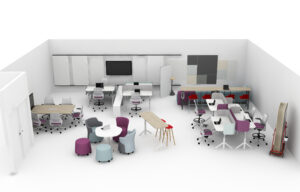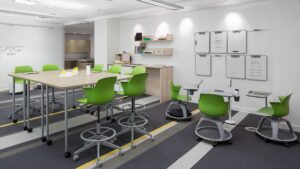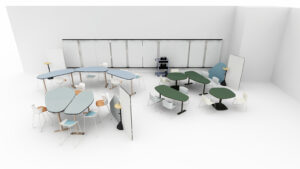Start Small, Learn Big
For school leaders planning facility upgrades or classroom renovations, every investment must support better student outcomes. That’s why many K–12 schools are starting small—with pilot learning environments—before implementing changes district-wide. These short-term, small-scale classroom trials let students and educators “live in” a new environment and provide real-world feedback to guide smarter, more student-centered design decisions.
 Why Pilot?
Why Pilot?
Pilot spaces offer more than a sneak peek—they’re evidence-generating tools. When done well, pilots reveal how different layouts, technologies, and furniture support collaboration, engagement, and teaching strategies. Teachers can experiment with modern pedagogies, students can explore flexible spaces, and decision-makers can see what works before scaling up. It’s a low-risk way to test ideas and avoid costly missteps.
Building Confidence Across Your School Community
Pilots empower teachers, students, and administrators to play an active role in shaping their learning environments. Teachers gain hands-on experience with flexible spaces that better support group work and differentiated instruction. Students often feel more engaged and motivated in environments designed with them in mind. And when the school community sees the benefits firsthand, it’s easier to build momentum for broader change.
Why Steelcase’s Pilot Program Stands Out
Many organizations offer pilot programs, but Steelcase’s Pilot Program is the only one that combines immersive design with robust research methodologies—thanks to their proprietary Learning Environment Evaluation (LEE) process.
The LEE is a series of online surveys administered to both students and instructors. These surveys don’t just ask if people like the furniture—they measure meaningful outcomes tied to student success. Questions are designed to detect cognitive, behavioral, emotional, and academic engagement, and they align with the National Survey of Student Engagement (NSSE).
What makes the LEE so powerful is the depth and structure of its data:
-
Pre-surveys are administered to gather baseline perceptions before the pilot begins.
-
Post-surveys follow after approximately six weeks of use, allowing time for behavior patterns and learning habits to emerge.
-
The surveys evaluate key factors such as student mindset, sense of belonging, creativity, collaboration, critical thinking, and communication.
-
Instructors weigh in on how the environment supports their ability to teach the way they want, facilitate meaningful interactions, and encourage collaborative learning.
-
Data is compiled and analyzed into a comprehensive report, helping school leaders assess how the pilot impacted student engagement, teaching effectiveness, and overall satisfaction.
This isn’t anecdotal feedback—it’s statistically significant evidence gathered across 110 institutions, 16,594 students, and 664 instructors since 2016.

Let’s Explore the Possibilities
At Franklin, we believe that the best learning environments start with the right data. Our Education Team works with schools to design and implement pilot spaces that are aligned with educational goals and grounded in research. As a proud partner of Steelcase, we can help you leverage the power of the LEE to make informed decisions that benefit your entire school community.
Ready to explore a pilot learning space backed by real data? Connect with Franklin’s Education Team to get started.
